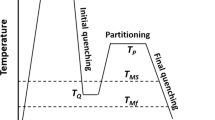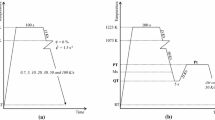In recent decade, there has been increasing interest in applying quenching and partitioning (Q&P) as a novel heat treatment for obtaining excellent combinations of mechanical strength and ductility in steel components. This process leads to microstructures containing martensite and carbon-enriched retained austenite in which martensite acts as a strengthening phase while retained austenite significantly contributes to the elongation due to the transformation-induced plasticity (TRIP) effect during the deformation. In this research, Q&P heat treatments in which the partitioning step is performed at a temperature equal to the quenching temperature were applied to a high Si and Mn steel, and the mechanical properties of the treated specimens were evaluated and discussed. According to the final results, considerable balances of strength and ductility were obtainable in Q&P treated specimens for application in the automotive industry such as B-pillar reinforcement, inner B-pillar, front floor side member, inner door panel, etc.






Similar content being viewed by others
References
E. De Moor, S. Lacroix, A. J. Clarke, et al., “Effect of retained austenite stabilized via quench and partitioning on the strain hardening of martensitic steels,” Metall. Mater. Trans. A, 39, 2586 (2008).
L. Wang and J. G. Speer, “Quenching and partitioning steel heat treatment,” Metallogr. Microstruct. Anal., 2, 268 (2013).
J. G. Speer, D. K. Matlock, B. C. De Cooman, and J. G. Schroth, “Carbon partitioning into austenite after martensite transformation,” Acta Mater., 51, 2611 (2003).
X. D. Wang, Z. H. Guo, and Y. H. Rong, “Mechanism exploration of an ultrahigh strength steel by quenching–partitioning–tempering process,” Mater. Sci. Eng. A, 529, 35 (2011).
L. Yang, L. Yu-peng, W. Chong, et al., “Phase stability of residual austenite in 60Si2Mn steels treated by quenching and partitioning,” J. Iron Steel Res. Int., 18, 70 (2011).
M. J. Santofimia, L. Zhao, R. Petrov, et al., “Microstructural development during the quenching and partitioning process in a newly designed low-carbon steel,” Acta Mater., 59, 6059 (2011).
B. D. Cullity, Elements of x-Ray Diffraction, Addison-Wesley Publishing Co., Inc., (1978), 2nd ed.
B. Karunagaran, R. T. R. Kumar, D. Mangalaraj, et al., “Influence of thermal annealing on the composition and structural parameters of DC magnetron sputtered titanium dioxide thin films,” Cryst. Res. Technol., 37, 1285 (2002).
N. Rahmani Nasab, S. Baghshahi, M. A. Shahbazi, and M. Tamizifar, “The effect of substrate temperature on growth of nanosilver layer deposited on white glass by magnetron sputtering,” J. Color Sci. Technol., 2, 41 (2008).
H. R. Ghazvinloo and A. Honarbakhsh-Raouf, “Effect of partitioning time on microstructural evolution of a C–Mn–Si steel in one-step quenching and partitioning process,” J. Mater. Environ. Sci., 6, 1988 (2015).
B. V. N. Rao and G. Thomas, “Structure-property relations and the design of Fe–4Cr–C base structural steels for high strength and toughness,” Metall. Trans. A, 11, 441 (1980).
X. D. Wang, B. X. Huang, Y. H. Rong, and L. Wang, “Mechanical and transformation behaviors of a C–Mn–Si–Al–Cr TRIP steel under stress,” J. Mater. Sci. Technol., 22, 625 (2006).
S. Zhou, K. Zhang, Y. Wang, et al., “High strength-elongation product of Nb-microalloyed low-carbon steel by a novel quenching–partitioning–tempering process,” Mater. Sci. Eng. A, 528, 8006 (2011).
Author information
Authors and Affiliations
Corresponding author
Rights and permissions
About this article
Cite this article
Ghazvinloo, H.R., Honarbakhsh-Raouf, A. & Rashid, A.R.K. Mechanical Properties of a High Si and Mn Steel Heat Treated by One-Step Quenching and Partitioning. Metallurgist 59, 90–96 (2015). https://doi.org/10.1007/s11015-015-0066-9
Published:
Issue Date:
DOI: https://doi.org/10.1007/s11015-015-0066-9




